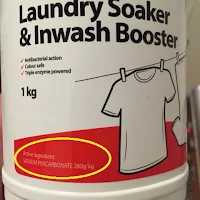Yes, you do bloody have to clean, sanitize and sterilize your beer brewing equipment, right down to the bottle caps and stirring spoon
and stirring spoon
There are plenty of tricks and cheats you can do to product quality tasting beer but the one thing you can't escape from is the proper cleaning, sanitizing and sterilization of your beer gear.
There's a difference between sanitizing and sterilizing
Sanitizing is a technical term that means a certain allowable amount of microbes to survive on the surface of your equipment.
Sterilizing is like sanitizing, but it removes all the microorganisms (the bugs and germs that will ruin your beer).
 Think of washing your hands with hot water and soap as sanitization as it kills a few bugs but not all and is an acceptable means of cleaning your hands.
Think of washing your hands with hot water and soap as sanitization as it kills a few bugs but not all and is an acceptable means of cleaning your hands.If you want to kill all the bugs on your hand so the skin is sterile with no bugs on it anywhere, then I suggest you boil your hands in water...
For the most part, the typical homebrewers don't need to sterilize, only sanitize. The chemicals commonly used for homebrew brewing are made to sanitize.
Now we've got those definitions clear, there are several methods that you can try to 'sterilize' your gear.
We'll note a couple in detail:
You can drown everything in bleach
A cheap and cost effective way to get your gear free of bugs is to drown your gear in bleach.
But what is bleach?
Bleach is usually a solution of chemicals such as sodium hypochlorite or hydrogen peroxide and they act as an oxidizing agent. They are great for all kinds of things such as removing bad smells, making your whites whiter and your brights brighter and for home brewing.
A popular American brand of bleach is Chlorox but there are hundreds of brands of bleach you could use.
but there are hundreds of brands of bleach you could use.
But what is bleach?
Bleach is usually a solution of chemicals such as sodium hypochlorite or hydrogen peroxide and they act as an oxidizing agent. They are great for all kinds of things such as removing bad smells, making your whites whiter and your brights brighter and for home brewing.
A popular American brand of bleach is Chlorox
As with all these sterilizing methods, you simply soak your equipment in the solution for a good length of time. A quick dip of ten minutes is the bare minimum.
We try and do several hours of soaking if possible.
The trick with bleach is to remember that you need to rinse everything off with clean water after. This is done to ensure that no yucky flavours leftover from the bleach makes it into your batch of beer.
We try and do several hours of soaking if possible.
The trick with bleach is to remember that you need to rinse everything off with clean water after. This is done to ensure that no yucky flavours leftover from the bleach makes it into your batch of beer.
Use sodium percarbonate as a sanitizing agent
Using sodium percarbonate is our preferred method as it works well, no rinsing is required and it's very easy to order in bulk online.
And it does not smell like chlorine does.
If you've ever tried to buy sodium percarbonate from a specialist beer brewery shop, you'll know that you can get a small bottle or container of it that will cost you a small fortune.
from a specialist beer brewery shop, you'll know that you can get a small bottle or container of it that will cost you a small fortune.
If you can buy it in bulk from an online supplier, you'll do well to nab some as using it will effectively bring down your cost per brew.
If you've ever tried to buy sodium percarbonate
If you can buy it in bulk from an online supplier, you'll do well to nab some as using it will effectively bring down your cost per brew.
To use sodium percarbonate you simply add it to water. I like to add hot or ever boiling water to the drum so as to get the action of the chemical happening pretty quickly. The boiling water also helps kill off any nasty bugs hiding about as well.
Here's another trick, this chemical is basically what you might know as Tide or Napisan or any product
or Napisan or any product that's brand name tries to use the word 'oxy' as in oxygen cleaning or oxidization agent.
that's brand name tries to use the word 'oxy' as in oxygen cleaning or oxidization agent.
Chances are you already have some in your home laundry so feel free to use that. I have done so several times with no problems whatsoever.
Non scented house brands are awesome.
Chances are you already have some in your home laundry so feel free to use that. I have done so several times with no problems whatsoever.
Non scented house brands are awesome.
Other methods of sanitization and sterilization
- Applying heat - use your oven for a good dry heat.
- Boiling in water with your camping stove or burner
- Use an autoclave
or pressure cooker
(this seems like a bit of overkill though)
- An ordinary house dishwasher machine can be used for sanitation but remember it's not likely to clean the inside of the bottles as well as you might wish, rather you are using the heat of the dishwasher to kill any microbes.
The key goal here is to make sure that your equipment is nice and clean and that it has a few microbes on it is possible. You can use whatever means you like to achieve this but you have to do it and you must be consistent.
You cannot take a break from it. If you want a good tasting beer that's not contaminated then you just have to take the plunge.
You cannot take a break from it. If you want a good tasting beer that's not contaminated then you just have to take the plunge.
If you are looking for a product to CLEAN your brewing equipment then we suggest you consider using PBW:
PBW stands for Powdered Brewery Wash
PBW cleaning product by Five Star is widely used in many commercial breweries but countless homebrewers across the land have cottoned on to how they can use it for cleaning their own brewing equipment.If you've ever used a 5 gallon stainless steel boil pot you'll know how crusty the remnants on the bottom of the pot can be. A quick round with PBW will sort them out easily. All you have to do when cleaning with hot water, is add just a little bit of PBW, mix it up, and let it sit in the pot. All of that burned-on garbage lifts right off. Ideally, a good burner will not cause this problem!
PBW is also excellent for cleaning the inside of your beer bottles, it can really clean out the beer's sediment.
The main ingredient is about 30% Sodium Metasilicate. Its chemical formula is Na2SiO3 and it's what kicks grease and beer smegma to the curb. If you want to be brave and buy the main ingredient in bulk, there's plenty of value on offer on Amazon.


0 comments:
Post a Comment